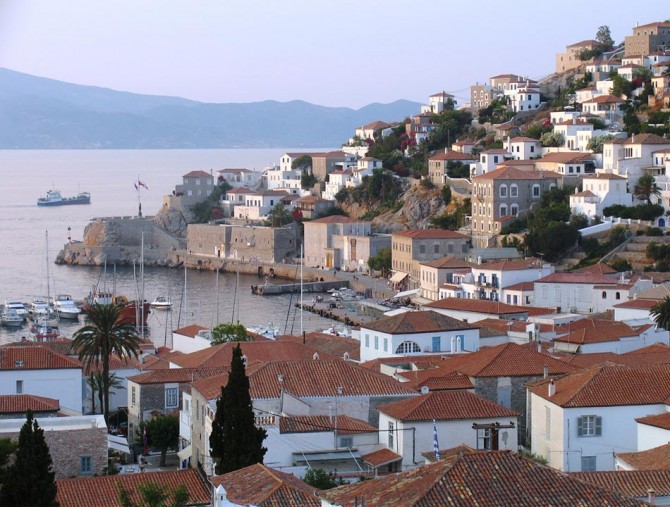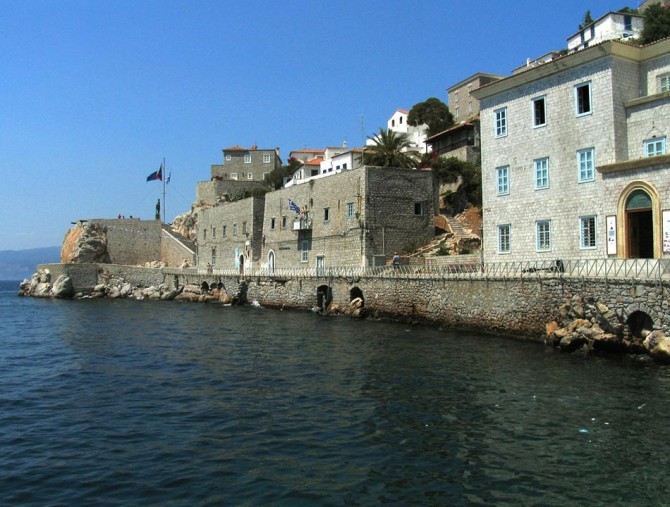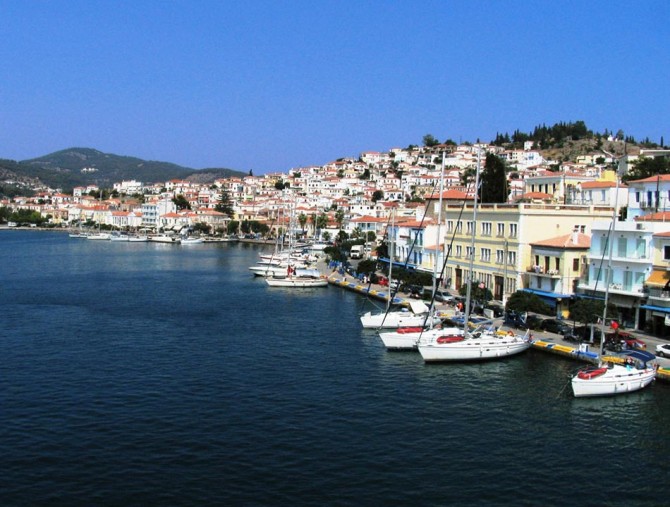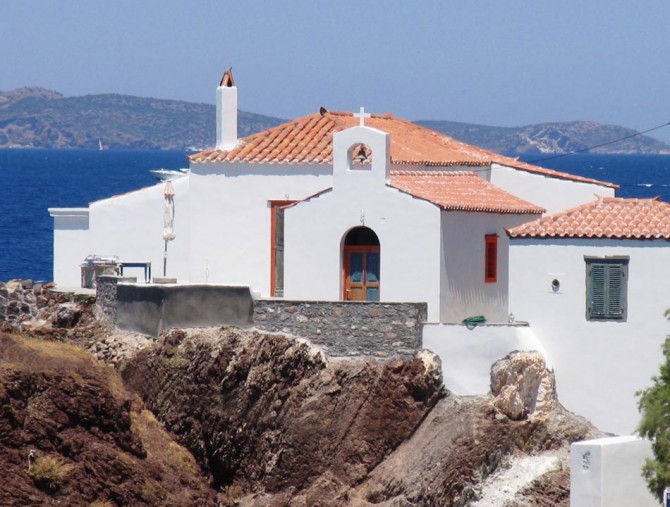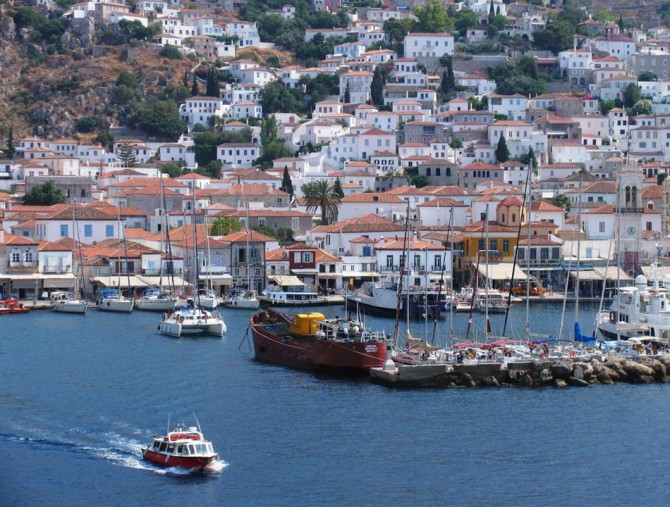Идра
Своим названием остров обязан огромному количеству водных ключей - слово “идрея” происходит от слова вода. В Микенский период остров населяло племя Дриопов. Скалистый остров, со скудной землёй, оставался в тени истории в течение тысячелетий. В XV веке н. э. на скалах острова нашло убежище бежавшее от турецкого нашествия греческое население соседнего Пелопоннеса, среди которого были представлены и многочисленные православные арнауты (албанцы). Последние, сплотившись в крепкий клан, оставили заметный след в местном говоре островитян, который сохранялся вплоть до конца XIX века. В русской литературе XVIII-XIX веков албанцев острова Идры иногда именовали “гидриотами”. Скудная земля была не в состоянии прокормить население, которое обратилось к морю. Со временем идриоты (и греки, и албанцы) стали отличными моряками. Развивалось на острове и кораблестроение. Этапами подъёма острова Идры стали Кючук-Кайнараджийский мирный договор в 1774 году позволивший греческим судовладельцам нести русский флаг.
А период Наполеоновских войн корабли греческих судовладельцев прорывали блокаду французских портов установленную английским флотом. Одновременно корабли Идры начали, с 1803 года, пересекать Атлантику, доходя до столицы Уругвая Монтевидео. Открывшиеся морские пути дали возможность некоторым жителям Идры эмигрировать в Южную Америку.
На скалистой и бедной природными ресурсами Идре не было турецкой администрации - однако, остров был обязан поставлять ежегодно 250 моряков на Турецкий флот. В 1821 году во время греческого восстания многие богатые судовладельцы острова без особого энтузиазма восприняли весть о начале войны с турками. Понадобился бунт экипажей, под руководством А. Иконому чтобы корабли Идры присоединились к кораблям уже восставшего против турок соседнего острова Специ. Флот Идры стал одним из основных оплотов Греческой революции на море.
Размеры флота Идры делали его первым среди этих островов и, как следствие, первый адмирал Идры автоматически становился командующим всего революционного флота. Корабли Идры приняли участие практически во всех морских сражениях Освободительной войны. После обретения независимости население острова больше начинает заниматься рыбным промыслом.
Несмотря на маленькую площадь, на Идре можно увидеть порядка 300 храмов и 6 монастырей. В одном из них - монастыре Пророка Ильи на высоте 500 метров был заключен герой греческой революции Теодорис Колокотронис. С истетической точки зрения наиболее примечателен Успенский Монстырь XVII века, который находится в центре порта Идры. Здесь обязательно стоит посетить местный Византийский музей (он находится на территории моначтыря), в котором представлены как иконы XVIII века, так и церковная одежда тех времен. Говоря о музеях, стоит
знать, что здесь располагается Музей исторических архивов. Здесь хранятся порядка 18 тысяч документов XVIII века и 12 тысяч томов редких книг. Помимо этого тут можно увидеть немало редких артефактов, например оригинал устава героя революции Ригаса Ферейроса.
Еще одна достопримечательность Идры - Особняк Лазаря Кудуриотиса, крупнейшего греческого судовладельца и первого президента Греции. В этом особняке, построенном в XVIII веке часта устраиваются выставки и концерты. В особняке его брата Георгиоса Кудуриотиса, так же политика, находится Музей византийского искусства. Всего же остров подарил Греции пять премьер-министров и несколько десятков адмиралов. Также туристической популярности острова способствовал фильм “Мальчик на дельфине”. Этот фильм с Софи Лорен в главной роли снимался в 1957 году снимался именно здесь.
Несмотря на то что Идра остров совсем невеликий, тут вы найдете намало неплохих пляжей. Спилья и Хидронета больше подойдут любителям дайвинга, в то время как Влихи и Бисти - наиболее хорошо организованные пляжи. Пляж Лимнониза хорош для подводной охоты.
На острове Идра в свое время побывали немало известных художников - это и Пабло Пикассо, и Марк Шагал. Неудивительно, что с 1936 года здесь функционирует Филиал Афинской школы изящных искусств.
Как добраться до острова Идра:
- на скоростном судне на подводных крыльях “Летучий дельфин” из порта Пирея. Время в пути составит 1 час и 30 минут
Телефоны порта Пирея +30 210 41 99 000, порт Идры +30 22980 54 007/53 812
Tекст: Александр Фролов
Hydra
Small, picturesque and so beautiful, Hydra belongs to the islands of the Saronic Gulf. The only settlement of the island is developed around the port. The peculiar architecture of the houses, with main features the gray stone, the wood, the “kokkina” (a clay mortar color) and the white outline of the walls, is not found anywhere else in Greece. The beautiful cobblestone streets and the flower filled yards complete the magic. Since no cars or other wheeled vehicles are allowed on the island, you can only walk or use water taxis, which makes Hydra ideal for walking.
Approaching Hydra, what you will see first are the bastions with the cannons which frame the entrance of the port and were used to protect the island in the past. Over the left bastion there is the imposing statue of the admiral Andreas Miaoulis (don’t be impatient... We will tell you about him later) which was erected over the place where his bones were buried.
The name Hydra is known from the antiquity and was derived from the abundance of springs (ύδωρ in ancient Greek means water). The archaeological findings in the area of Episkopi show that the island was inhabited since the Neolithic times, but due to the dry and rocky soil, never managed to develop a significant city during the ancient and classical times. The difference was made though in the early 15th century, when Orthodox Albanians refugees merged with the few inhabitants and turned to the shipping and trade. In the late 18th century and early 19th century, Hydra was already a great naval power with a commercial fleet of 150 ships. In the Greek Revolution of 1821, the island’s fleet had a key role, contributing to the liberation of Greece. Among the great Hydrian captains and fire-raisers who emerged during the seven-year struggle, the admiral Andreas Miaoulis stood out. The “Miaoulia”, the great three-day festival of Hydra made in his
honor, is organized annually at the end of June (this year it will be held at June 26-28, 2015), including festivities during the day and impressive fireworks at night.
As a typical Greek island, Hydra is dotted with churches and monasteries. Actually, 300 churches and six monasteries are crammed into the 64,4 square meters of the island. Do not miss to visit the churches of Candlemas and Saint John the Faster, with the wonderful frescoes of the 18th century, and the church of St. Constantine of Hydra with wooden carvings and gilded iconostasis, built on the site where the home of the saint was, on the hill of Kiafa. In the twin monasteries Saint Eypraxia and Profet Elias, at a altitude of 500 meters in the Eros area, the hero of the Greek Revolution, Theodoros Kolokotronis, and other fighters had been imprisoned for a while in 1825. The monastery of Assumption of the 17th century though, which is the metropolitan church of Hydra, stands out. It is located in the center of the port, with trademark the big clock in its tall steeple, that announces the major religious events. In the Ecclesiastical and Byzantine Museum of
Hydra, “Saint Nikolaos Notaras”, housed on the west side of the monastery, on the site of the old cells, you will see vestments, relics dedications and icons of the 18th century mainly (visiting hours from April 1 to November 15, 10:00-17:00, closed on Monday).
Talking about the museums, you can also visit the Historical Archives-Museum of Hydra, near the Port Authority, on the east side of the harbor, which houses the museum-archive service and the Library. It hosts 18,000 documents from the early 18th to the early 19th century, 12,000 book titles, historical and literary, and dozens of interesting exhibits, such as the Original Charter of Rigas Ferraios (Greek writer, political thinker and revolutionary, who is considered national martyr and forerunner of the Greek Revolution of 1821) and the silver pycnometer with the embalmed heart of Andreas Miaoulis (open daily).
Other sight of the island is the imposing House of Lazaros Kountouriotis, the great ship owner of Hydra and first president of the Greek Democracy. Every August, the residents of Hydra honor him with the “Kountourioteia”, a rich six-day celebratory program, including tours in the museums on the island, exhibitions, screenings, lectures, presentations of books and sporting events. As it seems, the Hydrians never forget and always honor their heros. His mansion, built in the late 18th century, is a typical sample of the traditional architecture of Hydra and operates as part of the National Historical Museum. It is located in the west side of the harbor and is open daily. Also interesting is the house of Georgios Kountouriotis (Greek politician, prime minister in 1848 and brother of Lazaros) on the hillside, on the west side of the harbor, which houses the Museum of Post-Byzantine Art and History.
Although Hydra is a rather small island, the abundance and variety of its beaches is remarkable. They are all accessible on foot, by donkeys or water taxis and caiques. Others have sand or pebbles and other have rocks, but all of them have in common the amazing crystal clear waters. The popular ar rocky Spilia and Hydroneta, both ideal for diving in the deep sea water, the organized picturesque Vlichos with gray and reddish pebbles, the organized Bisti, the southernmost cove of the island, which is surrounded by high rocks and bordered by a gorgeous pinewoods, the old naval port Mandraki, which is the only sandy beach of the island, and the most beautiful beach of Hydra, Limnioniza, ideal for spearfishing, are a few among the many beaches of the island.
Dozens of bars, cafes, restaurants and taverns are spread in front of the port or the picturesque cobblestone streets, offering fun day and night. Hydra is a cosmopolitan island, the favorite spot of the yacht owners, ideal for the weekend or a longer stay. One thing is for sure: When you visit it, you will love it forever.
How to get there: By flying dolphin/flying cat from the port of Piraeus. The trip lasts about 1 hour and 30 minutes by flying dolphins and about 1 hour and 45 minutes by flying cats. Regular daily routes by Hellenic Seaways, tel.: +30 210 41 99 000 (Piraeus), +30 22980 54 007/ 53 812 (Hydra).
Τext: Marilou Pantazi

